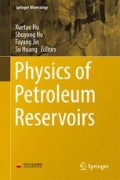Abstract
A rock capable of producing oil, gas, or water is called reservoir rock. A reservoir rock may be any rock with sufficient porosity and permeability to allow oil and gas to accumulate and be produced in commercial quantities [1]. Petroleum generally occurs in sandstones, limestones, dolomites, conglomerates, and shales, but sometimes it is also found in igneous and metamorphic rocks.
References
Daniel N, Lapedes (1978) McGraw-Hill encyclopedia of the geological sciences. Graw-Hill
Cecil GL(1949) Principles of petroleum geology. In: The century earth science series. Appleton-Century-Crofts, Inc., New York
Knut B (2010) Petroleum geoscience: from sedimentary environments to rock physics. Springer, London
Zhu XM (2008) Sedimentary petrography. Petroleum Industry Press, Beijing
Paolo N, Kornelia S (2006) Nucleic acids and proteins in soil. Springer, Berlin
Ruben DK, Nikolaĭ VP, Billy LE (2000) Coastal processes in tideless seas. ASCE Publications
Sam B Jr (2009) Petrology of sedimentary rocks, 2nd edn. Cambridge university press
Folk RL, Ward WC (1957) Brazos river bar: a study in the significance of grain size parameters. J Sediment Petrol 27:3–26
Folk RL (1966) A review of grain-size parameters. Sediment 6:73–93
Djebbar T, Erle CD (2012) Petrophysics: theory and practice of measuring reservoir rock and fluid transport properties. Gulf Professional Publishing, Waltham
Oleg DN, Stanislav N (2009) Handbook of non-ferrous metal powders: technologies and applications. Elsevier, Oxford
Carman PC (1938) The determination of the specific surface of powders. J Soc Chem Ind Trans Commun Lond 57(225)
Evangelos T, Arun SM (2011) Modern drying technology, experimental techniques. Wiley-VCH, Darmstadt
Brunauer S, Emmett PH et al (1938) Adsorption of gases in multimolecular layers. J Am Chem Soc 60:309–319
Jorden JR, Campbell FL(1984) Well logging I—rock properties, borehole environment, mud and temperature logging SPE of AIME
Richard CS (2000) Applied sedimentology. Academic, San Diego
Gary N (2009) Sedimentology and stratigraphy. Wiley-Blackwell, Oxford
Erik F (2004) Microfacies of carbonate rocks: analysis, interpretation and application. Springer
He GS (1994) Reservoir physics. Petroleum Industry Press, Beijing
Jacob B (1988) Dynamics of fluids in porous media. Courier Dover Publications
SY/T 6285-2011 (2011) Evaluating methods of oil and gas reservoirs (China)
Arville IL, Frederick FB (2001) Geology of petroleum. AAPG Foundation, 2001-6-1
Collins RE (1961) Flow of fluids through porous materials. Reinhold Publishing Corporation, New York
Society of Petroleum Engineers (2004) SPE reservoir evaluation & engineering
Richard A, Schatzinger, John FJ (1999) Reservoir characterization: recent advances. AAPG(71)
Ahr WM (2008) Geology of carbonate reservoirs: the identification, description and characterization of hydrocarbon reservoirs in carbonate rocks. Wiley, New Jersey
Epstein N (1989) On tortuosity and the tortuosity factor in flow and diffusion through porous media. Chem Eng Sci 44:777–779
Christopher H, William DH (2002) Water transport in brick, stone and concrete. Spon Press, London
Paul G (2001) Petrophysics MSc Course Notes.http://www2.ggl.ulaval.ca/personnel/paglover/CD%20Contents/GGL-66565%20Petrophysics%20English/Chapter%202.PDF; http://www2.ggl.ulaval.ca/personnel/paglover/CD%20Contents/GGL-66565%20Petrophysics%20English/Chapter%203.PDF
Carlson MR (2003) Practical reservoir simulation: using, assessing, and developing results. Penn Well Books, Tulsa
Bear J (1972) Dynamics of fluids in porous media. Dover Publications, New York
Yang SL et al (2004) Reservoir physics. Petroleum Industry Press, Beijing
Michael K (2006) Aquifer test data: analysis and evaluation. Water Resources Publication
Tucker ME (2011) Sedimentary rocks in the field: a practical guide. Wiley-Blackwell, Oxford
SY/T 5336-2006 (2006) Practices for core analysis (China)
He GS, Tang H (2011) Reservoir physics. Petroleum Industry Press, Beijing
Tarek A (2010) Reservoir engineering handbook. Gulf Professional Publishing, Burlington
Abdus S, Ghulam MI, James LB (2007) Practical enhanced reservoir engineering: assisted with simulation software. Penn Well Books, Tulsa
Pierre D (2007) Essentials of reservoir engineering. Editions Technip, Paris
Monicard RP (1980) Properties of reservoir rocks: core analysis. Editions Tecnip, Paris
Corelab (1983) Fundamentals of core analysis. Houston, TX
Engler T (2010) Saturation. http://infohost.nmt.edu/~petro/faculty/Engler524/PET524-3a-saturation
Helander DP (1983) Fundamentals of formation evaluation. OGCI Publications, Tulsa
Morris M (1949) Physical principles of oil production. McGraw-Hill Book Co
Henry D, Henry PG (2003) Darcy and other pioneers in hydraulics: contributions in celebration of the 200th birthday of Henry Philibert Gaspard Darcy. Pa. ASCE Publications, Philadelphia
Nalco Chemical Company (1979) The NALCO water handbook. McGraw-Hill
Klinkenberg LJ (1941) The permeability of porous media to liquids and gases. Drilling and production practice. American Petroleum Inst, pp 200–213
Torsæter O, Abtahi M (2003) Experimental reservoir engineering laboratory work book. http://faculty.ksu.edu.sa/shokir/PGE463/Textbook%20and%20References/Exerimental%20Reservoir%20Engineering%20Laboratory%20Workbook.pdf
Beard DC, Weyl PK (1973) Influence of texture on porosity and permeability of unconsolidated sand. AAPG Bulletin J 57(2):348–369
Faruk C (2011) Reservoir formation damage. Gulf Professional Publishing, Burlington
Amethyst G (2007) The clay mineral group
Collins DR, Catlow CA (1992) Computer simulation of structures and cohesive properties of micas. Am Mineral 77:1172–1181. http://www.swac.umn.edu/classes/soil2125/doc/s11ch1.htm
Carroll D (1959) Ion exchange in clays and other minerals. Geol Soc Am Bull 70:749–779
Ladd CC (1960) Mechanisms of swelling by compacted clay. In: Highway research board bulletin, national research council, vol 245. Washington, DC, pp 10–26
Joerg R, Tobias B, Reiner D, Siegfried S (2011) Moisture expansion as a deterioration factor for sandstone used in buildings. Environ Earth Sci J63:1545–1564
Shen P (1995) The experimental technique of reservoir physics. Petroleum Industry Press, Beijing
SY/T 5358-2010 (2010) Formation damage evolution by flow test (China)
Author information
Authors and Affiliations
Corresponding author
Editor information
Editors and Affiliations
Rights and permissions
Copyright information
© 2017 Petroleum Industry Press and Springer-Verlag Berlin Heidelberg
About this chapter
Cite this chapter
Hu, X., Huang, S. (2017). Physical Properties of Reservoir Rocks. In: Hu, X., Hu, S., Jin, F., Huang, S. (eds) Physics of Petroleum Reservoirs. Springer Mineralogy. Springer, Berlin, Heidelberg. https://doi.org/10.1007/978-3-662-53284-3_2
Download citation
DOI: https://doi.org/10.1007/978-3-662-53284-3_2
Published:
Publisher Name: Springer, Berlin, Heidelberg
Print ISBN: 978-3-662-53282-9
Online ISBN: 978-3-662-53284-3
eBook Packages: Earth and Environmental ScienceEarth and Environmental Science (R0)

